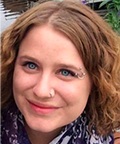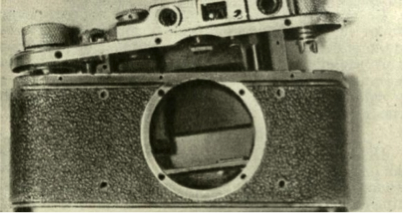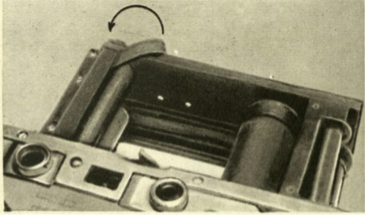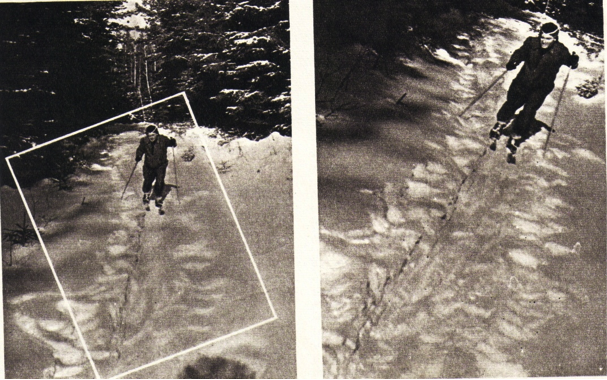In its early days, photography occupied an awkward middle ground between documentation and an art form, a debate which dragged on in the west for decades. The debate took place in the Soviet Union as well, where it was encouraged, discouraged, and then encouraged again in a roller-coaster of official policies between the eras of Lenin, Stalin, and Khrushchev. This interplay reveals a surprising amount about the lives of the artistically inclined Soviet middle class.
Guest Jessica Werneke has just completed her doctorate that looks at this oft-overlooked aspect of Soviet society, and discusses the turbulent world of amateur photography in the Soviet Union.
Guests
 Jessica WernekeLecturer in History, Loughborough University (UK)
Jessica WernekeLecturer in History, Loughborough University (UK)
Hosts
 Christopher RosePostdoctoral Fellow, Institute for Historical Studies, The University of Texas at Austin
Christopher RosePostdoctoral Fellow, Institute for Historical Studies, The University of Texas at Austin
A lot of people are familiar with the beginnings of amateur photography here in the United States–companies like Eastman Kodak, and companies like that–but as I was thinking about today’s episode before coming to the studio, I realized I know absolutely nothing about the movement in the Soviet Union. Presumably Kodak wasn’t a big force over there, so can you tell us about the beginnings of the amateur photography movement?
In the Soviet Union, the beginnings of amateur photography as a club activity began in 1894 with the establishment of an organization called the RFO, which loosely translates to the “Russian Photographic Organization.” Granted, because photography at the time was a rather expensive hobby, most of these photographers were well off to say the least. However, they were very interested in the aesthetic potential of photography, and the ability to manipulate photographs. One of the things they were particularly interested in was discussing how the human form moves, and how you can translate that into photography. That’s really the beginnings of the movement in the Soviet Union.
So, more of a human aesthetic as opposed to landscapes, seem to be the interest?
Landscapes as well–when you’re photographic something that doesn’t move, it’s a little bit easier. The more technically skilled photographers were interested in the human body, but they were also interested in choreography, they were interested in movements of the human body, and just the general tenor of what was going on in Western Europe in terms of what was acceptable to photograph.
You’ve mentioned that they were looking at Western Europe, but obviously that have must have changed with World War I and the 1917 Revolution. How was photography effected by the revolution and the war?
Documentary photography in World War I does exist – it’s not actually my specialty, what I tend to focus on in amateur movements in the 1920s is artists who found photography particularly interesting. Here, I’m talking about the constructivist movement, which is divided into two very distinct groups – of course, there are extraneous parts of it, but for the purposes of our talk today, there’s a group called Oktober, which is led by Alexander Ramachenko, whose primary artistic background is painting but he got into industrial design and various other media, and then Leonid Mezercher, who was very much a government bureaucrat but also interested in the aesthetic aspects of photography. And these two competing groups – they had photographers coalesce around them – had very different ideas about the properties of photography.
The Revolution, in terms of photography, meant that photographers were interested in a new type of documenting in the Soviet Union. It was very mass culture, very mass produced, interested in artistic aspects of media reaching the masses. You see a sort of leveling of high and low art, and that’s why so many artists chose photography, particularly photographers who were interested in revolutionary movements.

One associates, perhaps naively so—I’m not a Soviet historian—that period with a lot of government oversight. Were there attempts to control what people could take photographs of, or what was or was not officially sanctioned as art, or was that not yet a real concern of the government?
Between 1917 and around 1932, it was not necessarily without oversight, but not the priority of the government. There’s a lots of things happening in the Soviet Union that took priority over mass culture. Particularly in Leninist philosophy there were lots of competing groups, and that was completely fine. This changes in the year 1932 when Stalin begins to pull on the reigns of power and wants to present a united front in terms of the artistic community and this applies to photographers as well.
What happened to the photographic movement after this mass consolidation under Stalin? At what point does it start to become more open again?
Well, for amateur photographers the year 1932 or thereabouts marked the end of the amateur movement that began around 1894. This meant that in order to photograph you had to have the requisite permits in order to snap pictures. And this effectively ends the amateur movement until around the 1950s when all of a sudden these restrictions are not enforced in the same way.
Was there a change in the government at that time that allowed that to happen, or popular demand?
There are two congruent — or similar — events that happen. First of all, there’s an influx of photographic technology from Germany, and that occurred as a result of war reparations. The second event is Khrushchev’s cultural thaw and the ability for artistic movements to–albeit trepidatiously — start to investigate areas outside of the Stalinist milieu, otherwise known as socialist realism in Soviet art.

What does this do for the amateur photography movement?
Well, in terms of access to cameras and chemicals and film, especially, this is a breakthrough. For the first time in many, many years the average Soviet citizen was able to pick up a camera and snap photographs of whatever they wanted within reason, and this has to do with accessibility. It also has to do with the camera technology taken from Germany which allows them to have handheld cameras. So, what was happening with Eastman Kodak in the early 20th century is now starting to appear in the Soviet Union.
Since you’ve mentioned state approved artistic movements, were the photographs that were being taken as part of this re-invigoration of amateur photograph intended for public display, or were people taking what we would consider family snapshots and keeping them private, or was it a combination of both?
It’s generally a combination of both – my research focuses on photographers who were part of the amateur photography movement, but were also in discussion with public discourses about photography. Keeping in mind that the public discourses about photography were very small at the time, they were in contact with major journals and newspapers, and photojournalists. What we see from this type of amateur is a real thirst for information: how to develop photographs, how to use chemicals, how to photograph in a general style that fits in with the photojournalistic idea of what was acceptable. This began in the early 1950s and becomes more prevalent in this small community in the mid-1950s with the reestablishment of the journal Sovetskoe Foto, which is the premier photography journal in the Soviet Union, which continued into the 1990s.
How organized were these sort of collectives of photographers? You mentioned that there was lobbying for more resources, more access to information — was there an organized element to it?
Organization was by and large nonexistent. There were two general sources of institutional organization. The first was the Union of Journalists, which dealt mostly with professional photographers. The second were photography clubs, which were springing up all over the Soviet Union in the mid- to late 1950s and early 1960s, some of which in Moscow and Leningrad could boast memberships of 300, 500, 700 members, and were very prominent in those cities. In terms of organization, many amateur photographers from rural areas really wanted regulation, they wanted organization, and they wanted these clubs in their cities, whether regional capitals or very small rural centers as well.
What did these photography clubs do? What were their activities?
Photography clubs, depending on their location, in the larger cities—Moscow, Leningrad, places like Yekaterinburg—would involve weekly or biweekly lectures by prominent photojournalists in the area, they would involve competitions with rewards, or awards for those who did particularly well, and really the goal of clubs were to get amateur photographers up to standard with photojournalists and have the documentary aesthetic properties that published photojournalists had.
What happens later on is that these clubs become more and more demanding of the members. They become more exclusive. They don’t tolerate deviations from the replication of official photographs. It becomes less about creativity and more about replicating the status quo. This happens in the late 1960s and especially leading into the late 1970s where clubs require photographers to frequently update their portfolios in order to remain members of the club.

E. Volkov, Skiing, black-and-white photographs, Sovetskoe foto, no. 1 (January 1959)
We discussed the consolidation under Stalin initially. With this reopening of amateur photography in the Khrushchev era, was there still this issue of what were and were not considered acceptable styles of photography?
Absolutely. Generally, at least at the professional level, journals like Sovetskoe Foto and professional photojournalists really wanted amateur photographers to model the style that they were using in official publications. And what this entails was basically a sort of watered down version of what photographers were doing in the 1920s and 1930s, sort of avant-garde-ish, if you will. Some abstraction, some cropping, unusual angles in photographs, and this is what Sovetskoe Foto and professional photojournalists really wanted amateurs to replicate in their own work. That being said, it was not always easy for amateurs to replicate these styles. Many of them constructed darkrooms in their own flat bathrooms, so they would hang up curtains and develop their own images there, and that does not really translate to the sort of cropping that one can do in a studio or in a darkroom in an official newspaper. But this was still very much a requirement if you wanted to publish your photographs, if you wanted to exhibit your photographs at a local exhibition, this was the style you were supposed to emulate. And if you didn’t, your images were open to critique, especially if they were then published elsewhere and photojournalists had access to them.
What would be the ramifications of having a work critiqued publicly?
More often than not, the images that were deemed unacceptable were not published. The exception to this would be an amateur who tried and failed at replicating these various components or technical styles that were supported. The ramifications would be that a prominent photojournalist would say, “This is unacceptable, you subscribe to formalism, you subscribe to naturalism,” these various key terms that were used in the 1920s and 1930s to discredit photographers.
Some styles were clearly more officially accepted than others. Did they remain consistent, or did they evolve over time?
In some ways. In terms of the arguments made by photojournalists, discourses about photography and art peaked in about 1962. What these photojournalists were arguing was that photography was, in fact, art. This never received public recognition. However, after 1962, and the height of the Khrushchev era thaw, these discourses devolve into photography being something between documentary and artistic. They never gave up that artistic element, but they settled for a happy medium. And what this meant was that after 1962, the revitalization and vigor of the amateur photography movement started to wane. What was initially a project of “we can participate in productive leisure, we can also exhibit—we can show our images and they do something for the community,” changes really after 1962, and especially in the late 1960s and early 1970s when amateur photographers feel as though their creative needs are not being met by official guidelines.